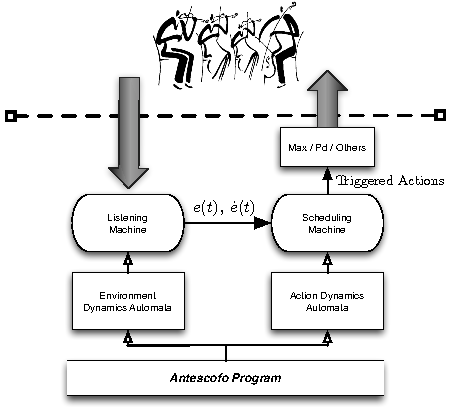Section: Software and Platforms
Antescofo
Participants : Arshia Cont, Jean-Louis Giavitto, Florent Jacquemard, José Echeveste.
Antescofo is a modular polyphonic Score Following system as well as a Synchronous Programming language for musical composition. The module allows for automatic recognition of music score position and tempo from a realtime audio Stream coming from performer(s), making it possible to synchronize an instrumental performance with computer realized elements. The synchronous language within Antescofo allows flexible writing of time and interaction in computer music.
Antescofo is developed as modules for Max and PureData real-time programming environments.
A complete new version of Antescofo has been released on November 2013 on Ircam Forumnet . This version is the result of one year of intensive effort by MuTant team members and associate artists.
This release include major improvements on the reactive language: richer set of synchronization strategies and control structures, dynamic continuous actions, high order function and processes, historicized variables and dynamic expressions everywhere (delays or periods as variables or expressions).
The new internal architecture unifies completely the handling of external (musical) events and the handling of internal (logical) events in a framework able to manage multiple time frames (relative, absolute or computed).
The new version targets the Max and PureData (Pd) environments on Mac, but also on Linux (Pd version) and offers also a standalone offline version. The standalone version is used to simulate a performance in Ascograph.
An important enhancement has been made by proposing a richer set of synchronization strategies between the event recognized by the listening machine and the action to be performed by the reactive engines. Theses new strategies include anticipative strategies that exhibits a smoother musical behavior. These strategies are now tested in various musical situations like accompaniments and in the creation of new pieces.
Some new results including a behavioral semantics of the static kernel of the Antescofo reactive engine [17] and tools for formal verification and conformance testing of the system [24] , [35] are presented below.


